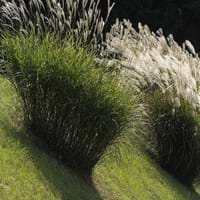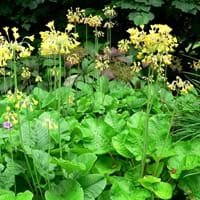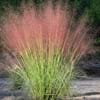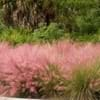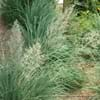Life Span
Perennial
Perennial
Origin
Hybrid origin
Eastern Europe, Southern Europe, Russia/Siberia, Southern Asia, Western Asia
Types
Not Avaialble
Not available
Habitat
Lake Sides, savannahs
Roadsides, sand dunes, Waste areas
USDA Hardiness Zone
5-9
6-9
Sunset Zone
1a, 1b, 2a, 3a, 3b, 4, 5, 6, 7, 8, 9, 10, 11, 12, 13, 14, 15, 16, 17, 18, 19, 20, 21, 22, 23, 24
1a, 1b, 2a, 2b, 3a, 3b, 4, 5, 6, 7, 8, 9, 14, 15, 16
Habit
Clump-Forming
Oval or Rounded
Flower Color
Not Available
Pink, Hot Pink, Rose
Flower Color Modifier
Bicolor
Bicolor
Fruit Color
Not Available
Yellow, Yellow green, Pink, Dark Red
Leaf Color in Spring
Green
Green
Leaf Color in Summer
Light Green
Green
Leaf Color in Fall
Green, Purple, Burgundy, Bronze
Green, Light Yellow, Brown
Leaf Color in Winter
Not Available
Light Green
Leaf Shape
Grass like
Oblong
Plant Season
Summer, Fall
Summer
Sunlight
Full Sun, Partial Sun
Full Sun, Partial Sun
Type of Soil
Clay, Loam, Sand
Loam, Sand
The pH of Soil
Acidic, Neutral
Acidic, Neutral, Alkaline
Soil Drainage
Average
Well drained
Bloom Time
Early Summer, Summer, Late Summer, Early Fall
Early Summer, Summer, Late Summer
Tolerances
Drought
Drought
Where to Plant?
Ground
Container, Ground, Pot
How to Plant?
Rhizome division
Divison, Seedlings, Stem Planting
Plant Maintenance
Medium
Low
Watering Requirements
Average Water Needs, Do Not over Water
Average Water Needs, Do Not over Water, Never Over-water, Requires regular watering, Water more in summer
In Summer
Lots of watering
Lots of watering
In Spring
Moderate
Moderate
In Winter
Average Water
Average Water
Soil pH
Acidic, Neutral
Acidic, Neutral
Soil Type
Clay, Loam, Sand
Loam, Sand
Soil Drainage Capacity
Average
Well drained
Sun Exposure
Full Sun, Partial Sun
Full Sun, Partial Sun, Partial shade
Pruning
Remove damaged leaves, Remove dead branches, Remove dead leaves
Remove damaged leaves, Remove dead branches, Remove dead leaves
Fertilizers
All-Purpose Liquid Fertilizer
All-Purpose Liquid Fertilizer, fertilize in growing season
Pests and Diseases
No serious insect or disease problems
Slugs, Snails
Plant Tolerance
Drought
Variety of soil types
Flower Petal Number
Single
Single
Foliage Texture
Coarse
Medium
Foliage Sheen
Glossy
Matte
Attracts
Crickets
Not Available
Allergy
Not Available
Abdominal pain, Constipation, Diarrhea, Skin irritation
Aesthetic Uses
bank hedging, Mixed Border, Showy Purposes
Beautification, Borders, Landscape Designing, Showy Purposes
Beauty Benefits
Not Available
Good for skin, Making cosmetics, Stops hair loss
Environmental Uses
Air purification
Air purification, Food for insects, Versatility
Medicinal Uses
No Medicinal Use
Eczema
Part of Plant Used
Whole plant
Root
Other Uses
Screen, Used as Biofuel, Used for making hedge
Decoration Purposes, Medicinal oil, Showy Purposes, Used as Ornamental plant, Used for its medicinal properties
Used As Indoor Plant
No
Yes
Used As Outdoor Plant
Yes
Yes
Garden Design
Hedges, Mixed Border, Screening / Wind Break
Edging, Feature Plant, Groundcover, Mixed Border
Botanical Name
MISCANTHUS Giganteus
MALUS domestica 'Pink Pearl'
Common Name
Giant Silvergrass
Apple, Eating Apple, Pink Pearl Apple
In Hindi
Giant Silvergrass
Tibetan cowslip
In German
Riesenschilf
Tibet-Primel
In French
géant silvergrass
Kauslip tibétain
In Spanish
Giant Silvergrass
Primula florindae
In Greek
Giant Silvergrass
Primula florindae
In Portuguese
Silvergrass gigante
cowslip tibetana
In Polish
Giant Silvergrass
tybetański cowslip
In Latin
Giant Silvergrass
Primula florindae
Phylum
Magnoliophyta
Magnoliophyta
Class
Lilopsida
Magnoliopsida
Family
Poaceae
Onagraceae
Genus
Miscanthus
Oenothera
Clade
Angiosperms, Commelinids, Monocots
Angiosperms, Eudicots, Rosids
Tribe
Andropogoneae
Onagreae
Subfamily
Panicoideae
Onagroideae
Number of Species
Not Available
Season and Care of Giant Silvergrass and Tibetan cowslip
Season and care of Giant Silvergrass and Tibetan cowslip is important to know. While considering everything about Giant Silvergrass and Tibetan cowslip Care, growing season is an essential factor. Giant Silvergrass season is Summer and Fall and Tibetan cowslip season is Summer and Fall. The type of soil for Giant Silvergrass is Clay, Loam, Sand and for Tibetan cowslip is Loam, Sand while the PH of soil for Giant Silvergrass is Acidic, Neutral and for Tibetan cowslip is Acidic, Neutral, Alkaline.
Giant Silvergrass and Tibetan cowslip Physical Information
Giant Silvergrass and Tibetan cowslip physical information is very important for comparison. Giant Silvergrass height is 240.00 cm and width 120.00 cm whereas Tibetan cowslip height is 370.00 cm and width 460.00 cm. The color specification of Giant Silvergrass and Tibetan cowslip are as follows:
Giant Silvergrass flower color: Not Available
Giant Silvergrass leaf color: Green
Tibetan cowslip flower color: Pink, Hot Pink and Rose
- Tibetan cowslip leaf color: Green
Care of Giant Silvergrass and Tibetan cowslip
Care of Giant Silvergrass and Tibetan cowslip include pruning, fertilizers, watering etc. Giant Silvergrass pruning is done Remove damaged leaves, Remove dead branches and Remove dead leaves and Tibetan cowslip pruning is done Remove damaged leaves, Remove dead branches and Remove dead leaves. In summer Giant Silvergrass needs Lots of watering and in winter, it needs Average Water. Whereas, in summer Tibetan cowslip needs Lots of watering and in winter, it needs Average Water.
